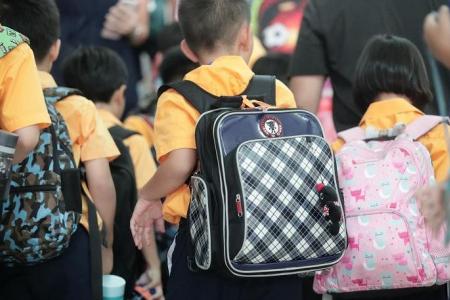How will changes to Primary 1 registration affect my child?
The annual Primary 1 registration exercise will start on June 29. It will be conducted online, same as in the last two years.
Under changes announced in 2021, the number of places reserved for Phase 2C - meant for children who do not qualify for priority admission to primary schools - will double to 40 from this year.
The Ministry of Education (MOE) will also combine Phases 2A1 and 2A2 in 2022.
This means children whose parents are in the alumni association of the school will not have priority over those who have parents or siblings who used to study in the school. They will now compete in the same phase.
The Straits Times addresses parents' questions on the changes and the registration exercise.
Q: Why did the MOE decide to reserve 40 places for Phase 2C? Were 20 spots not enough?
A: The number of places reserved for Phase 2C was doubled to enable more children who live nearby and have no prior links to the school to obtain a place in the school.
Since the 2014 Primary 1 registration exercise, MOE has set aside 20 places each for Phases 2B and 2C in every primary school. This was the first step in ensuring that schools remain accessible to children without prior connection to the school, it says.
It had observed in subsequent years that a few schools needed the 20 reserved spots to ensure they remained accessible and, by 2021, this had gone up to six schools.
The MOE says the number of schools with 40 or fewer places in Phase 2C also increased from 19 in 2014 to 32 last year.
"If these trends continue, those who live within 2km of the school will find it increasingly difficult to gain admission," it adds.
Q: Why did MOE combine Phases 2A1 and 2A2?
A: Priority for alumni members was introduced in Phase 2A1 in 1999 to encourage stronger alumni and community support for schools.
The MOE says it is timely to review the fine differentiation of priority between Phases 2A1 and 2A2 as, over time, more former students and alumni associations have been actively contributing to their schools.
It adds: "The increase in reserved places for Phase 2C will result in fewer places in earlier phases. Several schools may end up with relatively few or no places left for Phase 2A2 registrants if priority between Phase 2A1 and Phase 2A2 registrants continued to be differentiated."
Hence, combining both phases into a simplified Phase 2A would help to preserve access for Phase 2A2 registrants, who might otherwise have no spots left.
Q: How does the new way of calculating home-school distance work and how will it affect admissions? Does it mean that more homes will be considered both within 1km and 2km of schools?
A: From 2022, home-school distance will be calculated from any point on the boundary around the school to the registrant's home.
This "school land boundary" is much less likely to change over time, says MOE, and is a more stable basis to compute the home-school distance compared with previously using a single reference point.
This change would result in a slightly larger coverage of residential addresses within 1km and 2km for all primary schools, says MOE, which expects slightly more than 10 per cent of applicants per primary school to fall under a nearer home-school distance category, for example, from outside 2km to between 1km and 2km.
Q: Why are all these changes being introduced at the same time?
A: The changes are implemented at the same time as they are interconnected, says MOE.
If Phases 2A1 and 2A2 were not merged while increasing the number of reserved places in Phase 2C, there would possibly be fewer or no places left in Phase 2A2 for several schools.
"Where some parents may be concerned about the home-school distance change, as this could mean more competition for places at a particular school, we hope the doubling of reserved places at Phase 2C would help address such concerns," says the ministry.
Q: Can I use different addresses to register my child under different phases?
A: At any one time, you can register your child using only one address for one school at any phase.
If your child has already secured a place in an earlier stage, you will need to withdraw the child from the school before he or she can register in another phase that the child is eligible for, whether you are using the same or a different address.
The MOE says the address used in the Primary 1 registration exercise should be the parents' official residential address as reflected on their NRICs.
In certain cases, parents may register their child using the address of a caregiver living within 2km of their preferred primary school or the address of a yet-to-be-completed or resale property they have purchased and will be moving into.
Regardless of which address is used for registration, a child who gains priority admission due to distance from school is required to reside at this address for at least 30 months.
For those using their parents' official NRIC address or caregiver's address, the 30 months takes effect from the start of the registration exercise, which is June 29 for 2022.
For more information on the conditions that parents have to meet, go here.
If this requirement is not met, MOE can transfer your child to another school with vacancies.
Q: If the property I have bought near the school of my choice is still under construction at the time of registration, can I use that address to register my child?
A: You can register your child for Primary 1 using the address of a yet-to-be-completed property, as long as you have evidence from the relevant authority that you have committed to the purchase of the property.
After registering online, you must e-mail one of these documents to the school during the phase you are registering for:
For Housing Board flat: A copy of the Agreement For Lease, which can be downloaded from MyHDBPage.
For private property: A copy of the original sales and purchase agreement.
The vacant or delivery possession date of the new property you are moving into must be within two years of your child's entry into Primary 1.
You will also need to digitally sign a letter of undertaking to commit to moving into your new property within two years.
Q: Why is registering for primary school so stressful?
A: Enrolling your child for Primary 1 is a milestone, but it is also just the beginning of a journey for your family. Registering for primary school can seem overwhelming with all the different rules and stages, but it does not have to be a stressful process, if you set some clear goals.
There are some things to take note of if you are trying to get your child into a popular school. Typically, such schools require balloting because they tend to be oversubscribed. To avoid the anxiety of this balloting process, refer to previous years' numbers to check the rate of applications and vacancies left during the phase your child is eligible for.
List a few other schools near your home as options and check their balloting history to see if you stand a good chance of getting in.
Location and home-school distance are important as they could mean significant convenience (or inconvenience) for your family for the next six years. Spending two hours on the road each day could also mean less time for other activities or hobbies.
Choose a school that will suit your child in terms of learning style or other programmes such as co-curricular activities and, most importantly, help him or her thrive.
Get on-the-ground feedback by talking to parents, whose children are already in schools that you are interested in, to find out what their experiences have been like.

Get The New Paper on your phone with the free TNP app. Download from the Apple App Store or Google Play Store now



